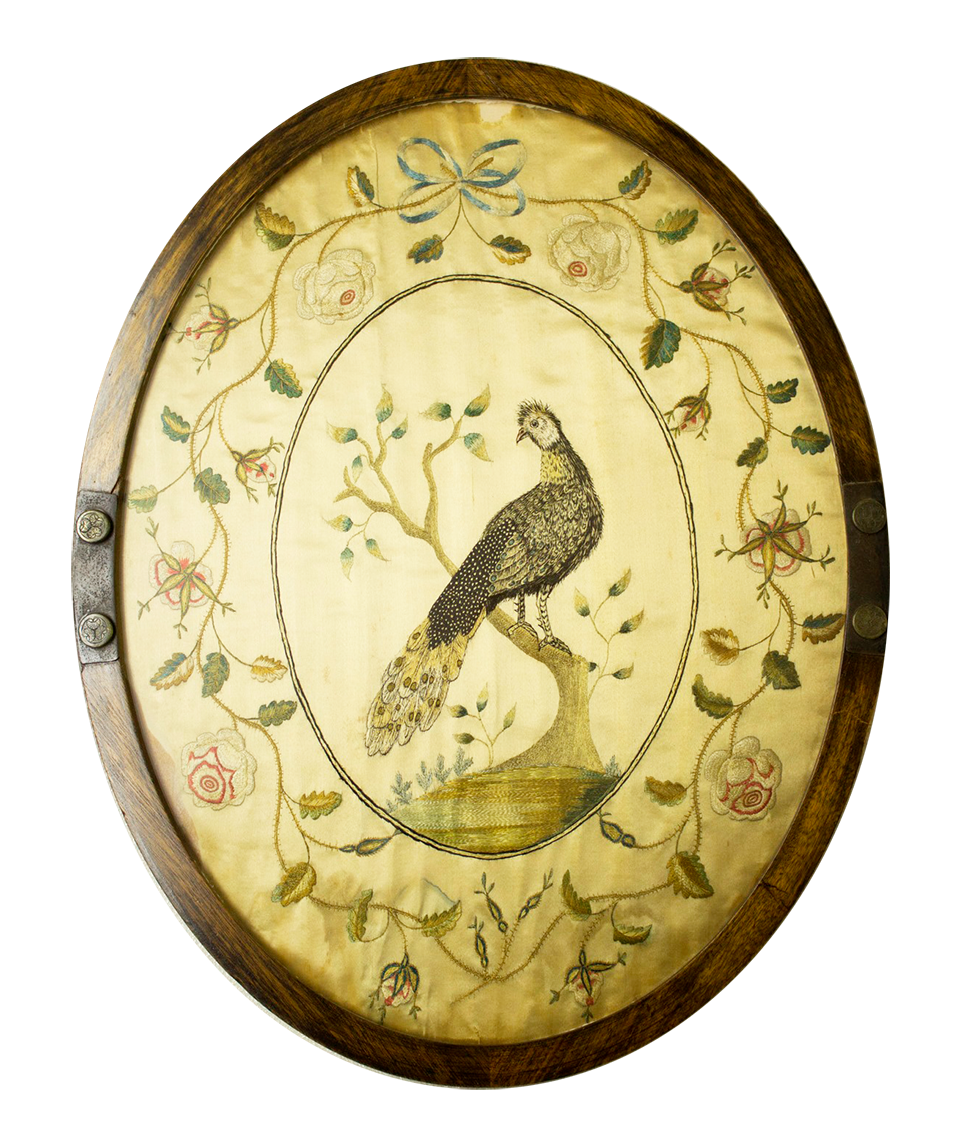 Shown here is the panel from a pole screen, dating to c. 1805, roughly the middle of the Federal period of architecture and furniture design in the then-recently created United States. Consisting of an oval mahogany frame (and pole stand, not pictured) with an image of a peacock embroidered in silk on a silk background, the pole screen was in the Longfellow House parlor when the National Park Service assumed stewardship of the site in 1972. Although this pole screen is not currently exhibited in the Longfellow House’s historic interior spaces, it is just one of several examples of Federal-era furnishings still in the house, including a set of Adam Hains–designed chairs in the parlor, and a girandole mirror with carved wooden eagle hanging over the fireplace in Henry Longfellow’s study.
Shown here is the panel from a pole screen, dating to c. 1805, roughly the middle of the Federal period of architecture and furniture design in the then-recently created United States. Consisting of an oval mahogany frame (and pole stand, not pictured) with an image of a peacock embroidered in silk on a silk background, the pole screen was in the Longfellow House parlor when the National Park Service assumed stewardship of the site in 1972. Although this pole screen is not currently exhibited in the Longfellow House’s historic interior spaces, it is just one of several examples of Federal-era furnishings still in the house, including a set of Adam Hains–designed chairs in the parlor, and a girandole mirror with carved wooden eagle hanging over the fireplace in Henry Longfellow’s study.The pole screen’s date of manufacture raises several questions – Was it originally one of the Craigie family’s furnishings retained by Henry and Fanny Longfellow after their 1843 acquisition of the home? Was it a piece chosen by another Longfellow family member to furnish the mostly Victorian style parlor as a nod to earlier American tastes? Why does the screen’s frame feature two metal fittings with the symbol of a Japanese clan?
The purpose of a pole screen was to shield a person from overly intense heat emanating from an open fireplace. During an era when many people wore heavy makeup, pole screens helped to protect the wax and other elements of cosmetics from melting on the face due to the wearer’s proximity to the fire. The screen’s peacock design may be a nod to this function, as the bird’s image was often used to symbolize skin-deep beauty and vanity. Screens were attached to poles with adjustable brackets, allowing them to move up and down their mounting pole to shield persons of differing heights more effectively, or to be swapped out entirely with different screens. Perhaps the screen was used by Elizabeth Craigie who married Andrew Craigie in 1793 shortly after he purchased and expanded the home at 105 Brattle Street. She later rented rooms on the second floor of the house to Henry Wadsworth Longfellow.
The metal fittings attached to either side of the mahogany frame are a peculiar feature of the pole screen. Made of bronze, they feature the crest, or “mon”, of the Tokugawa clan from Japan. Members of the Tokugawa clan ruled Japan as shoguns from the early 17th to mid-19th centuries. Whether they were attached to the pole screen as reinforcing measure or simply to further decorate the piece is unknown. The fittings may have come from another piece of furniture in the Longfellow House collections, a Japanese room screen dating to the mid-19th century, obtained by Charles Longfellow during his extended trip to Japan in 1871-1873. The Japanese screen was made during the last decades of the Tokugawa period which might explain the use of the clan’s crest, and that date along with evidence of missing elements that align with the pieces now on the pole screen suggest their origin. The Longfellow family used other detached elements of Japanese items as decorative pieces in their home as well.
